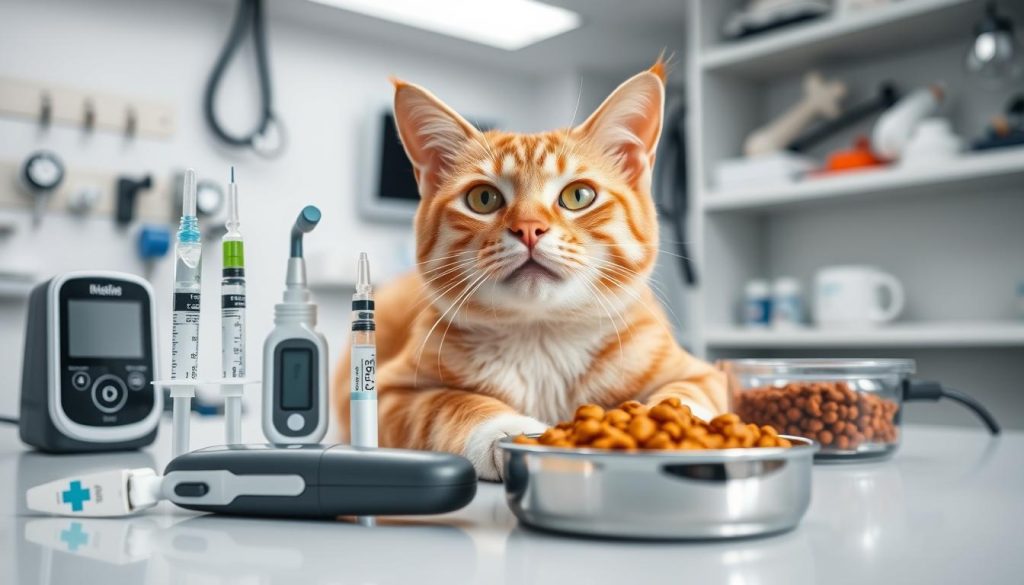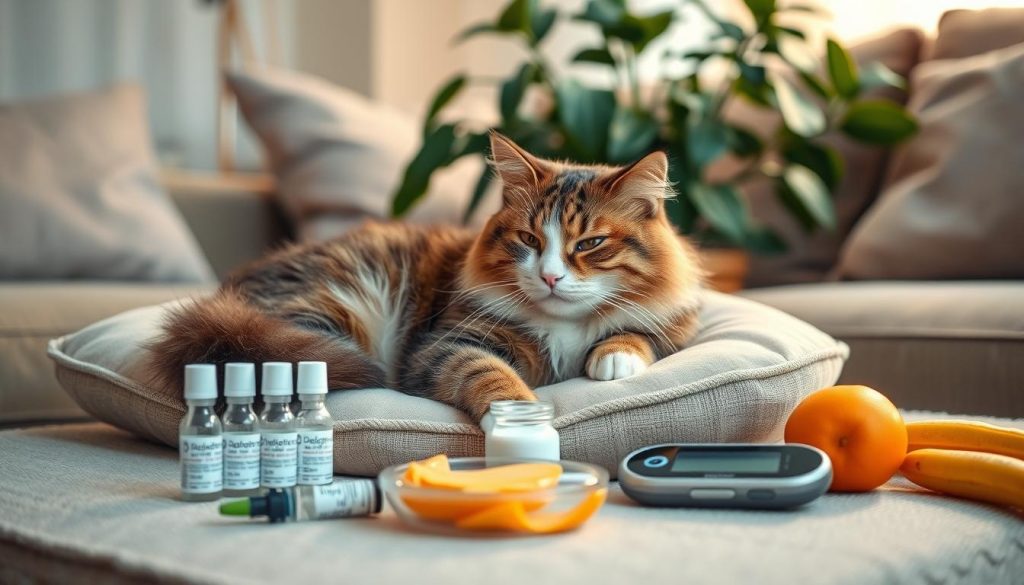Keeping your feline health in top shape is a big deal for many pet owners. When a cat is diagnosed with diabetes mellitus, it’s a big challenge. It’s a lifelong condition that needs careful management to keep your cat happy and healthy.
This means more than just following a routine. It’s about creating a treatment plan that fits your cat’s needs. It’s about making lifestyle changes that help your cat live a full life.
Learning how to care for a diabetic cat is key. You’ll need to give insulin shots and control their diet. Regular check-ups with the vet are also essential.
With the right care, your cat can avoid serious health problems. They can even live a happy, active life.
Creating a supportive home and sticking to a routine is vital. It helps your cat feel secure and loved every day.
Understanding Feline Diabetes and Its Prevalence
Diabetes mellitus in cats is a growing concern. It’s vital to understand and manage it for their health. Research shows that more cats are getting diabetes, highlighting the need for owners and vets to watch for diabetes risk factors in cats.
For those interested in how health issues like diabetes affect wellbeing, including hair health, check out HealthWith.com. It offers important insights.
The Basics of Diabetes Mellitus in Cats
Diabetes in cats is similar to the human version. The body can’t make or use insulin well, causing blood sugar levels to rise. In cats, it’s usually because they don’t make enough insulin or can’t use it right.
Epidemiology: How Common Is Diabetes in Felines?
Feline diabetes epidemiology shows that how common it is varies. Diet, age, and how active a cat is can affect this. Being overweight is a big risk factor for cats to get diabetes.
Identifying High-Risk Groups for Diabetes in Cats
It’s important to know the diabetes risk factors in cats to catch it early. At-risk cats include those that are overweight, older, and certain breeds. Watching for these signs can help prevent and treat diabetes mellitus in cats.
Key Symptoms of Feline Diabetes to Watch Out For
Early detection of diabetes in cats is key to effective management. Spotting symptoms of feline diabetes early can prevent serious complications. It’s vital for cat owners to know the first signs.
The most common diabetic symptoms in cats are increased thirst and urination. Cats may also show changes in appetite and weight loss, even if they eat more. These signs can point to diabetes or other health issues.
- Increased thirst and frequent urination
- Weight loss despite increased appetite
- Lethargy or decreased activity
- Poor coat quality
Being a pet owner means watching for health changes. If you see any of these signs, think about diabetes in cats. Talk to a vet for a diagnosis and treatment. Quick action can greatly improve a diabetic cat’s life.
Insulin for Cats: The Cornerstone of Diabetes Management
Managing diabetes in cats is all about knowing the different insulins, how to give them, and dealing with insulin resistance. Getting these right can greatly improve a cat’s life and keep them healthy.
Types of Insulin Used in Feline Diabetes Care
There are many insulin for cats to fit different needs. The right insulin depends on the cat’s diabetes type and health. Some insulins work fast, while others last longer to keep blood sugar steady.
How to Administer Insulin and Dosage Considerations
Insulin shots for cats are given under the skin, usually in the neck or back. It’s important for owners to learn how to do this right to avoid hurting their pets. Also, the dose might need to change based on blood sugar tests to keep it just right.
Understanding Insulin Resistance in Cats
Insulin resistance is a big issue in cat diabetes care. It happens when a cat’s body doesn’t use insulin well, making it hard to control blood sugar. Things like being overweight, other health issues, or long-term meds can cause it, so treatment needs to be carefully planned.
| Type of Insulin | Onset | Duration | Common Use |
|---|---|---|---|
| Rapid-acting | 15 minutes | 2-4 hours | Quick glucose control |
| Long-acting | 1-2 hours | 14-24 hours | Maintained glucose stability |
Glucose Monitoring in Cats: Methods and Frequency
It’s key to keep an eye on glucose levels in cats with diabetes. This helps adjust insulin doses and keeps blood glucose levels just right. We’ll look at the ways to monitor glucose in cats, the benefits of blood glucose testing, and the balance between home glucose monitoring and vet visits.
Benefits of Regular Blood Glucose Testing
Checking blood glucose levels often can stop dangerous highs and lows. It shows how your cat reacts to treatment and diet changes. This helps give better care that’s more focused and effective.
Home Glucose Monitoring vs. Veterinary Testing
Home glucose monitoring is easy and less stressful for pets. But vet tests can give deeper insights. Let’s compare the two:
| Aspect | Home Monitoring | Veterinary Testing |
|---|---|---|
| Frequency | Can be done daily | Periodic detailed assessments |
| Stress Level | Lower | Higher, due to travel and new environments |
| Cost | Lower in long term | Costly per visit |
| Data Type | Brief, regular readings | Detailed, includes more variables |
Understanding Your Cat’s Glucose Curve
Glucose curves are vital for seeing how well insulin works. They show how insulin affects blood glucose levels over time. Knowing when glucose levels rise and fall helps manage your cat’s diabetes better and lowers the risk of problems.
Diet Management: Feeding a Diabetic Cat
Managing feline diabetes starts with a good diet. Knowing how diet affects glucose levels and health is key.
The Role of Diet in Feline Diabetes Management
Diet is critical in controlling a diabetic cat’s blood sugar. A diet high in protein and low in carbs is best. It helps keep blood sugar stable, preventing dangerous spikes.
Recommended Foods and Diet Plans for Diabetic Cats
Feeding times and amounts must be consistent to manage blood sugar. Meals should be protein-rich and low in carbs. Adjustments to the feeding schedule may be needed based on your cat’s insulin plan.

Supplements and Treats: What’s Safe for a Diabetic Cat?
Choosing safe supplements for diabetic cats is important. Look for products that don’t affect glucose levels. Treats should also be carefully selected, preferably made for diabetic cats.
The Impact of Lifestyle on Feline Diabetes
Creating a good lifestyle for diabetic cats is key. It includes regular exercise and managing their environment. These steps help keep their blood sugar levels stable.
Exercise: An Essential Aspect of Managing Diabetes
Exercise is vital for diabetic cats. It helps keep their blood sugar in check. It boosts insulin sensitivity and helps control weight. But, the right exercise depends on the cat’s health, so it’s important to tailor it.
Environmental Factors That Influence Blood Glucose Levels
Keeping the environment stable is important for diabetic cats. Stress and sudden changes can affect their blood sugar. So, it’s best to keep their surroundings calm and consistent.
| Exercise Type | Benefits | Frequency |
|---|---|---|
| Gentle Play | Increases metabolism, enhances mood | Daily |
| Cat Trees/Climbing | Builds muscle, improves agility | 2-3 times a week |
| Interactive Toys | Stimulates mind, combats obesity | Daily, varying toys |
Diabetes Mellitus in Cats: Recognizing the Signs Early
It’s key to spot the early signs of diabetes in cats to catch it early. This helps in diagnosing feline diabetes and managing diabetes in cats well. The sooner symptoms are noticed, the better the cat’s treatment and health.
Look out for signs like drinking more water and peeing a lot, losing weight without eating more, and being less active. If you see these signs, it’s time to get your cat checked by a vet for diabetes.
| Symptom | Description | Action |
|---|---|---|
| Increased Thirst | Drinking more water than usual, which could be a reaction to excess glucose in the bloodstream. | Measure daily water intake and consult a vet if it increases significantly. |
| Weight Loss | Unexpected weight loss even when eating habits have not changed. | Monitor weight regularly and discuss changes with your vet. |
| Lethargy | Less activity or decreased interest in play, pointing to lower energy levels. | Keep a log of your cat’s activity levels; discuss any sudden drops with a vet. |
By recognizing the early signs of diabetes in cats, owners can work with vets to diagnose feline diabetes quickly. Watching for symptoms, talking to vets, and following treatment plans are key. This helps keep the cat’s diabetes in check and improves their life quality.
Administering and Monitoring Feline Diabetes Treatments
Managing feline diabetes treatment needs careful attention in administering insulin and monitoring diabetic cats. It’s important to pick the right insulin delivery method and keep accurate records. These steps are key to your cat’s health and happiness.
Syringe vs. Pen: Choosing the Best Method for Your Cat
Getting insulin right is critical for managing feline diabetes. The choice between a syringe or insulin pen depends on your cat’s health, your comfort level, and your vet’s advice. Syringes are affordable and easy to find, but insulin pens offer a less painful, more convenient option with pre-measured doses.
Keeping a Record: Charting Your Cat’s Progress
Keeping a detailed log is more than just routine vet visits. It’s essential for tracking your cat’s health journey. These records help adjust insulin doses and give vets important information during check-ups. This way, any treatment changes can be made quickly and based on solid data.
| Method | Pros | Cons | Suitability |
|---|---|---|---|
| Syringe | Cost-effective, higher precision in dosage | Requires steady hand and comfort with needles | Recommended for caregivers comfortable with manual dosing |
| Insulin Pen | Easy to use, less stressful for cat | More expensive, requires prescription | Useful for those seeking convenience and minimal distress to the cat |
Risks and Complications of Diabetes in Cats
Managing diabetes in cats is important. It’s not just about high blood sugar. It can lead to serious health problems that affect their quality of life. We’ll look at major complications, including hypoglycemia and long-term effects of diabetes management.
Knowing the Signs of Hypoglycemia in Diabetic Cats
Hypoglycemia in cats is a serious condition that needs quick action. It can cause weakness, odd behavior, tremors, and even seizures or loss of consciousness. It’s vital to spot and treat it fast to avoid serious harm.
Chronic Complications: The Impact of Long-Term Diabetes
Managing diabetes long-term is key to avoiding chronic problems. These include nerve damage, kidney issues, and a higher risk of infections. Keeping blood sugar levels stable and using insulin correctly are important steps.
| Complication | Description | Management Strategies |
|---|---|---|
| Neuropathy | Weakness in the hind legs caused by nerve damage. | Regular physical therapy and veterinary monitoring. |
| Nephropathy | Kidney damage, potentially leading to failure. | Dietary adjustments, medications, and routine kidney function tests. |
| Infections | Higher risk of bacterial and fungal infections. | Keeping up with vaccinations and maintaining strict hygiene. |
Pharmacological Advances in Feline Diabetes Care
The world of veterinary medicine has seen big steps forward in feline diabetes advancements. New cat diabetes medication and new diabetes treatments make managing this chronic condition easier. Thanks to research, we now have advanced insulin and oral meds made just for cats.

New insulin therapies are changing the game. They help keep blood sugar levels stable for longer. This means cats might need insulin shots less often.
There’s also work on immunomodulators. These meds could help stop the immune system from attacking the pancreas. This could be a game-changer for type 1 diabetes in cats, maybe even making daily insulin shots a thing of the past.
| Treatment Type | Benefits | Potential Impact |
|---|---|---|
| Long-acting Insulin | Reduces frequency of injections | Improves quality of life |
| Oral Medications | Non-invasive administration | Enhanced acceptance by cats |
| Immunomodulators | Modulates immune destruction of beta-cells | May decrease need for insulin |
These new treatments aim to make life better for diabetic cats and their owners. They’re a bright spot in the future of managing feline diabetes.
Veterinary Care for Diabetic Cats: What to Expect
Managing diabetes in cats needs daily effort and special vet care. Knowing what your vet team can do helps you care for your cat better. Regular check-ups are key to keeping your diabetic cat healthy.
Regular Check-Ups and Ongoing Management
Regular vet visits are vital for diabetic cats. These visits check blood sugar levels and adjust treatments as needed. This ensures your cat stays healthy.
The Role of Veterinary Specialists in Diabetes Care
For complex cases, specialist care is essential. Vets with extra training in diabetes offer top-notch care. This can greatly improve your cat’s life.
Key components of effective diabetes management in cats include:
- Initial diagnosis and ongoing monitoring
- Nutritional management tailored to individual needs
- Regulation and adjustment of insulin therapy
| Aspect | General Vet Care | Specialist Diabetic Care |
|---|---|---|
| Focus | Overall health | Targeted diabetes management |
| Services | Standard check-ups, basic diabetes support | Advanced diagnostics, personalized treatment plans |
| Benefits | Essential health maintenance | Enhanced control of diabetes, complication management |
Managing Cat Diabetes with Holistic and Alternative Therapies
In recent years, more people are interested in holistic therapy for diabetes in pets. Cat owners are looking into different ways to help their pets with diabetes. They are interested in acupuncture for cats and herbal remedies for cats.
Acupuncture and Its Benefits for Diabetic Cats
Acupuncture is a traditional Chinese medicine that involves needles in specific points. It’s becoming a popular choice for diabetic cats. Research shows it might help manage diabetes symptoms and improve health.
It’s thought to balance the body’s energy flow or ‘Qi’. This could help insulin work better and improve glucose use.
Herbal Remedies: Are They Effective?
Herbal remedies for cats with diabetes are also being explored. Some herbs might help with diabetes, but their use in pets is debated. It’s important for cat owners to talk to vets before using these remedies.
Both acupuncture and herbal remedies are promising in treating cat diabetes. But, it’s key to have more research and vet advice to ensure safety and effectiveness.
Supporting a Cat with Diabetes: Owner Education and Resources
Dealing with feline diabetes is tough. It needs lots of knowledge and support. We’ll look at key resources and emotional help for cat owners. Learning about feline diabetes helps improve health and happiness for cats and their owners.
Educational Materials and Supportive Communities for Cat Owners
Every cat owner with diabetes needs the latest info. Guides, webinars, and forums are very helpful. Places like the American Veterinary Medical Association have lots of online resources. They cover diet, insulin, and watching for symptoms well.
- Printed guides and handbooks that explain glucose monitoring and insulin treatment comprehensively.
- Online forums and support groups where experiences are shared and advice is given by both experts and fellow pet owners.
Managing the Emotional Aspect of Caring for a Diabetic Cat
Supporting a diabetic cat can be hard on owners. It affects their well-being. Counseling and support groups are key for emotional help.
- Personal counseling to help deal with the stress and decision-making processes involved in a pet’s chronic illness.
- Community support groups that offer a network of support and firsthand insights from other cat owners navigating similar challenges.
Support for diabetic cats is more than just medical help. It’s about building a caring, informed community. This way, owners can manage their pet’s diabetes well. It ensures a good life for their cats.
Plan for Regular Health Assessments and Adjusting Treatments
It’s key to do health assessments for cats often. This is very important for cats with diabetes. These checks help watch how the disease is doing and make changes to treatment as needed. Cats’ health can change a lot, so regular visits to the vet are a must.
Keeping a close eye on a cat’s health and changing treatments as needed is very important for diabetic cats.
| Assessment Type | Purpose | Frequency |
|---|---|---|
| Physical Examinations | To assess general health and detect any physical changes | Every 3 months |
| Blood Glucose Monitoring | To measure and track glucose levels thoroughly | Weekly to biweekly |
| HbA1c Testing | To get an average of the past 2-3 months’ glucose levels | Every 3-6 months |
- Regular health assessments for cats help catch problems early and prevent bigger issues.
- Changing medication or diet is often needed based on these regular checks.
- Talking often with a vet helps owners keep their cat’s health in check, making sure each cat gets the right care.
In short, paying close attention to diabetic cats’ health through regular health assessments for cats can really help. These assessments give valuable insights for making the right treatment adjustments for diabetes. This leads to a better, happier life for cats with diabetes.
Emergency Situations: When to Seek Immediate Care
Knowing when to act fast is key in diabetic cat emergencies. Certain severe symptoms need immediate attention. Signs like disorientation, lethargy, or seizures in your cat are warning signs.
Also, symptoms of ketoacidosis, such as rapid breathing, dehydration, vomiting, or sweet-smelling breath, are critical. These signs mean your cat needs emergency care right away.
Managing a diabetic cat’s health is a continuous effort. But, seeing these severe symptoms is a clear reminder of the importance of balance. Quick action can make a huge difference in your cat’s recovery.
Stay calm but act fast if you face an emergency. Call your vet or an emergency pet clinic right away. Describe the symptoms you’ve seen. Your quick response is vital for your cat’s health.
Always have a plan for emergencies. Make sure anyone caring for your cat knows what to do. This way, you can all act quickly if needed.
FAQ
Q: What role does a cat owner play in managing diabetes mellitus in cats?
A: A cat owner is key in managing their pet’s diabetes. They give insulin, control the diet, and schedule vet visits. Keeping a regular treatment schedule is also important.
Q: Why is it important to manage feline diabetes effectively?
A: Managing diabetes well is key for a cat’s quality of life. It prevents complications and can even extend their life.
Q: How common is diabetes in cats, and are some at higher risk?
A: Diabetes in cats is becoming more common. Some cats, like older or overweight ones, are at higher risk. Early diagnosis and management are easier with awareness of these risks.
Q: What are the common symptoms of diabetes in felines?
A: Common symptoms include more thirst and urination, weight loss, and changes in appetite. Spotting these signs early can lead to timely treatment.
Q: What types of insulin are used to treat feline diabetes?
A: Cats may get different types of insulin based on their health needs. The type and dosage might change, like if insulin resistance develops.
Q: How is insulin administered to diabetic cats?
A: Insulin is given through subcutaneous injections. Owners need to learn how to do this correctly, often with their vet’s help.
Q: Why is glucose monitoring important in diabetic cats, and how often should it be done?
A: Glucose monitoring is key to manage insulin and diet. How often depends on the cat’s diabetes level. It may include home checks and vet tests.
Q: What dietary adjustments are needed for a cat with diabetes?
A: A high-protein, low-carb diet is often recommended. Feeding at the same times and in the same amounts helps control blood sugar.
Q: Can lifestyle changes impact a cat’s diabetes?
A: Yes, exercise helps with weight and insulin sensitivity. A stable routine also helps keep blood sugar levels stable.
Q: What are the early signs of diabetes in cats that owners should be vigilant about?
A: Early signs include lethargy, poor coat, and changes in appetite or weight. If you suspect diabetes, see a vet.
Q: How can cat owners monitor their pet’s diabetes treatment at home?
A: Owners can use syringes or insulin pens based on their comfort and the cat’s needs. Keeping a record of blood glucose and insulin doses helps track progress.
Q: What are the possible complications of unmanaged or poorly managed diabetes in cats?
A: Complications include hypoglycemia, neuropathy, nephropathy, and increased infection risk. Regular management and vet visits can help avoid these.
Q: Are there any new treatments for feline diabetes on the horizon?
A: New treatments are being researched, including new insulins and oral medications. There’s also hope for immunomodulators and therapies to help beta cells.
Q: What does veterinary care for a diabetic cat typically involve?
A: Vet care includes regular check-ups, treatment adjustments, and sometimes specialist consultations. This helps manage the cat’s diabetes effectively.
Q: Can holistic and alternative therapies benefit diabetic cats?
A: Some owners try holistic options like acupuncture or herbal remedies. Their effectiveness varies. Always discuss these with a vet.
Q: How can cat owners access support and education about feline diabetes?
A: There are many resources online and through vets. Support for owners is also important in managing a diabetic cat’s health.
Q: Why are regular health assessments and treatment adjustments important for diabetic cats?
A: Diabetic cats’ needs can change over time. Regular assessments and adjustments are key for effective management.
Q: What constitutes a diabetic emergency in cats, and what should owners do?
A: Severe hypoglycemia or ketoacidosis are emergencies needing immediate vet care. Signs include weakness, seizures, and loss of consciousness. Quick action is vital.


















